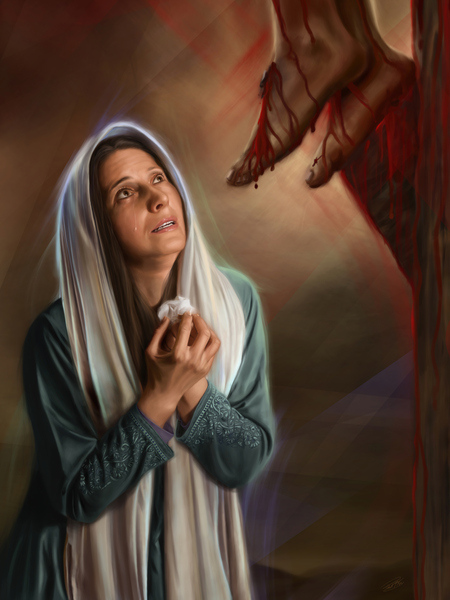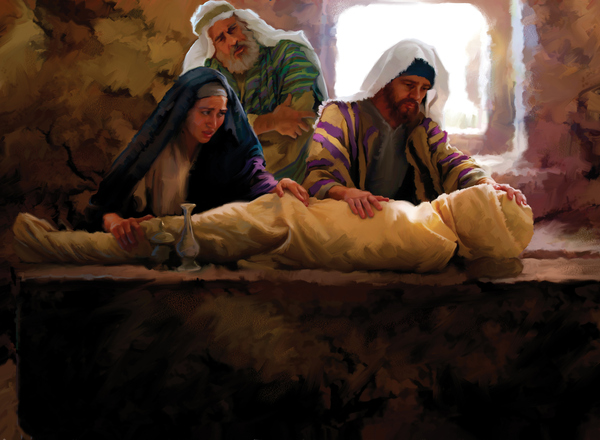Dearest hijas and hijo,

“Now on the first day of the week Mary Magdalene came early to the tomb, while it was still dark, and saw the stone already taken away from the tomb” (John 20:1).
Have you ever considered the life of Mary Magdalene? Who was she, really? Her life story as told to us in the gospels is a picture of redemption from sin and utter devotion to the LORD who forgave her and redeemed her that should be the pattern of every Christian. She is a classic example of hope, trust, and supreme gratitude that should exemplify every Christian’s attitude and relationship to Christ as LORD.
Picture the scene. It’s 28 A.D. The Romans occupy Israel. You’re a woman in a small fishing village called Magdala, on the western shore of the Sea of Galilee. You don’t know it, but you are demon-possessed. You don’t just have one demon controlling and tormenting your thoughts and actions, but seven. However, your life is about to change in a dramatic and forever eternal and ultimate way.
The gospels don’t tell us how she came in contact with Jesus. It has been wrongly assumed Mary Magdalene was the woman who washed Jesus’ feet in Luke 7:36-39 and that she was a prostitute and barfly as depicted in the popular TV series The Chosen. The Scriptures never give that identification to Mary Magdalene. She was also not secretly married to Jesus who mothered His descendants and later emigrated to France as depicted in the 2003 book and subsequent 2006 movie The Da Vinci Code.
We do know Mary Magdalene was demon-possessed from Luke 8:
“And it came about soon afterwards, that He began going about from one city and village to another, proclaiming and preaching the kingdom of God; and the twelve were with Him, and also some women who had been healed of evil spirits and sicknesses: Mary who was called Magdalene, from whom seven demons had gone out, and Joanna the wife of Chuza, Herod’s steward, and Susanna, and many others who were contributing to their support out of their private means” (Luke 8:1-3).
It was most likely during these visits by Jesus “from one city and village to another” in and around the Sea of Galilee that Jesus came in contact with her and healed her. We also know of her extraordinary devotion to Jesus after this healing which changed her life for eternity, especially those events surrounding His crucifixion and resurrection.

“Therefore the soldiers did these things. But there were standing by the cross of Jesus His mother, and His mother’s sister, Mary the wife of Clopas, and Mary Magdalene” (John 19:25, see also Mark 15:40-41, Matt. 27:55-56).
The twelve disciples had vanished after Jesus’ arrest in the garden, except Peter and another disciple known to the high priest (John 18:12-15). We don’t know where Mary Magdalene was at this time, but we do know she must have heard about the arrest and trial and death sentence given to Jesus because we see her at His execution. She’s standing there and listening along with the other women as Jesus tells John to take care of His mother (John 18:26-27). She and the other women remained there to the bitter end.
We next see her after the crucifixion when Jesus is laid in the tomb:
“And when it was evening, there came a rich man from Arimathea, named Joseph, who himself had also become a disciple of Jesus. This man came to Pilate and asked for the body of Jesus. Then Pilate ordered it to be given over to him. And Joseph took the body and wrapped it in a clean linen cloth, and laid it in his own new tomb, which he had hewn out in the rock; and he rolled a large stone against the entrance of the tomb and went away. And Mary Magdalene was there, and the other Mary, sitting opposite the grave” (Matt. 27:57-61).

Joseph of Arimathea asked for Jesus’ body from Pilate. Nicodemus (John 3:1) came also with a mixture of myrrh and aloes and it was then these two men who wrapped up Jesus’ body with the ointment as was the Jewish custom (John 19:38-42) and laid Him in the tomb.
They took great care in the process but it was hasty as the Sabbath was approaching and they had to finish up quickly before the Sabbath began as per Jewish law (Luke 23:53-56). Mary Magdalene and the other Mary (Luke says “the women who had come with Him out of Galilee,” Luke 23:55) evidently followed Joseph of Arimathea and Nicodemus and watched the men in the process of preparing Jesus’ body. She was there at the tomb so she now knows where He’s laid.
Fast forward three days. It’s early morning on the third day. You are still grieving at the loss of this man you have come to love who has touched your life in such a tender and miraculous way—like no other person you have ever met.
Yet you know He is more than just a man, but God-come-down, your personal Savior and the Savior of all mankind. You and some of the other women went out last night (Saturday night after the Sabbath had ended) and purchased more spices in which to finish the burial process of Jesus’ body (Mark 16:1-2). You and the other Mary (the mother of James and Joses), and Salome come back to the tomb. You’re wondering if the three of you can roll that heavy stone away so you can further anoint Jesus’ body with the spices you bought.
What? The heavy stone is already rolled away and the tomb entrance is wide open! What happened? You peek in, seeing a young man sitting there wearing a white robe and he says to you that Jesus the Nazarene is not here, He is risen (Mark 16:6). Fear and trembling and astonishment grip your heart and you run away, for the young man has told you to “…Go, tell His disciples, and Peter, He is going before you into Galilee, there you will see Him, just as He said to you” (Mark 16:7).
As you’re running your mind is racing as to what could have happened and you’re thinking that someone has stolen Jesus’ body. Not only did you witness his beatings and brutal death on a Roman cross, but now tragedy of tragedies and the body is gone.
Before you get too far you encounter Peter and John coming towards the tomb on the same trail (John 20:2). You tell them the body is gone. They sprint ahead of you and run towards the tomb while you follow them back more slowly. By the time you get back they’re already gone.
You’re now there by yourself and you begin to weep (John 20:11). Deep sobs rack your body in grief over the events of the last three days: Jesus’ crucifixion, His burial, and now today when you wanted only to lovingly anoint a dead body with spices and finish the process, you find Him gone.
As you stand there crying you walk over to the tomb entrance and stoop to look in again. You see two angels, one of whom asks you “Why are you weeping?” You answer him and then turn around and see another man standing there. You think he’s the gardener. He also asks you “Why are you weeping?”, and then asks “Whom are you seeking?” You assume that this gardener has taken Jesus’ body and moved it to another location.
He says one word, your name, and your heart lurches in your chest. You know that voice. You rush forward, all inhibitions gone, and hug him like you have never hugged anyone ever before. A hug of supreme joy that this One you loved and who had delivered you from the soul-destroying demons of your former life is now standing right in front of you (John 20:11-18). He was dead, but now alive!
Mary Magdalene was the first witness to Jesus’ resurrection. She will always be remembered and the honor goes to her as the first person to see the risen LORD. Her devotion to Him is an example of what it means to follow Christ. She was there through it all. Never wavering, remaining steadfast and faithful. Always trusting, no doubts. May we love our LORD with that same devotion.
All my love,
Dad
Vaya con Dios!